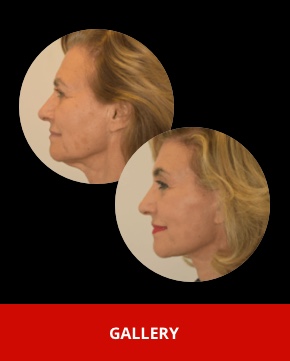Facelift and necklift risks
Facelift and necklift surgery offers patients the opportunity for rejuvenation ranging from subtle to dramatic. Technical innovations in recent years have continued to improve the safety of surgery but complications still do occur. Attention to detail through appropriate pre-operative assessment and meticulous intra-operative technique is essential to minimising the risk of complications.
Early post-operative complications
Haematoma
This is the most common early complication and can occur in up to 15% of patients. Increased risk occurs in patients with coagulopathies (bleeding disorders), high blood pressure, vomiting, coughing or straining. There is also increased risk with more significant surgery where larger skin flaps are created. Most haematomas are called “benign” and can be treated in the office by small procedures.
4% are considered major or “malignant” and are expanding in nature. Most major haematomas occur in the first 12 hours following surgery. They are more common in males due to increased blood flow in their thicker skin.
Infection
Infection is a rare complication of facelift and necklift procedures. Patients with diabetes mellitus, smokers and immunocompromise are at higher risk.
Skin flap necrosis
This refers to death of one of the layers of the skin. It is uncommon but has a higher incidents in patients with thin skin, haematomas and in smokers. Loss of skin can be just the superficial part or full thickness. It will heal with time.
Wound dehiscence (opening)
This is rare in facelift and necklift surgery but should it occur reclosure needs to be performed.
Facial nerve (motor nerve) injuries
Facial nerve injuries occur in 0.53% to 0.7% of facelift and necklift procedures. 85% of these will resolve completely without needing further treatment. Temporary weakness if often seen in the recovery room due to the effects of local anaesthetic. Other injuries can be related to the use of cautery to address bleeding. An injury typically involves one tiny branch of the facial nerve and not the entire trunk of the nerve. Due to interconnections there is usually full recovery with time.
Sensory nerve injuries
Temporary numbness for several weeks is very common in the face and neck. It is fairly unavoidable and is usually related to raising the skin flap. It usually completely resolves with time and requires no treatment.
Late post-operative complications
Abnormal wound healing
Incisions may occasionally widen during healing. This is more likely following a haematoma, infection or skin flap necrosis. It is most common behind the ear. Conservative use of steroid injections is helpful but most incisions will improve in appearance with time.
Earlobe distortion
Earlobes can be pulled inferiorly during healing. This can usually be avoided through conservative reduction of excess skin under the earlobe during surgery.
Unfavourable hairline changes
Changes in the hairline can largely be avoided through appropriate incision design. Men should be advised that portion of their beard will be advanced that may require shaving or permanent removal with electrolysis. Other hairline issues may be improved with hair grafting techniques.
Alopecia
Permanent hair loss after face and neck lifting is rare. Some temporary thinning in some areas may occur but growth normally returns to normal within a few weeks or months.
Contour irregularities in the neck
As oedema (swelling) resolves often the neck appears bumpy. Most of this will resolve within a few weeks with neck massage and time.
Platysmal banding
Some residual banding is common in patients presenting with severe submental banding pre-operatively. In some situations residual banding is due to scar contracture over the platysma. This can be managed with massage and neck rolling exercises combined with steroid injections.
Hyperpigmentation and hypervascularity
Hyperpigmentation may occur from activation of melanocytes or from iron pigment deposits in areas of bruising. It is most common in those that bruise easily and in darker skin. It usually resolves without needing treatment over several weeks or months. Sunscreen and steroid creams can be helpful in some situations.
In patients with thin skin, telangiectasia (small widened blood vessels in the skin) may occur. They usually resolve with time but can respond to laser treatment if needed. Red-haired individuals typically have red incisions for a prolonged period.
Submandibular gland ptosis
The submandibular gland normally descends with aging but it’s presence may be hidden by jowls, fat and skin. Occasionally after facelift and necklift surgery it will appear more prominent.
Traumatic tic
A very rare complication that has been reported after injury to a facial nerve branch. Generally it will respond to neuromodulator injections (eg botulinum toxin).
Chronic pain
Pain lasting more than 12 weeks is extremely rare but can occasionally occur if a neuroma forms during healing along one of the sensory nerves in the neck. The pain may feel “migraine-like” and often has a trigger point. Regional nerve blocks or medicines can give relief. The pain usually resolves after several months.
Parotid gland fistula
This is a very rare complication but may occur in patients with a very thin SMAS layer. If the parotid gland is inadvertently entered during surgery it can usually be closed over with residual SMAS. If a saliva leak develops post-operatively this may require drainage. Usually these then heal with time without any long-term effect.


